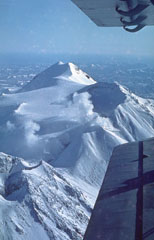Report on Zhupanovsky (Russia) — 10 September-16 September 2014
Smithsonian Institution / US Geological Survey
Weekly Volcanic Activity Report, 10 September-16 September 2014
Managing Editor: Sally Sennert.
Please cite this report as:
Global Volcanism Program, 2014. Report on Zhupanovsky (Russia) (Sennert, S, ed.). Weekly Volcanic Activity Report, 10 September-16 September 2014. Smithsonian Institution and US Geological Survey.
Zhupanovsky
Russia
53.589°N, 159.15°E; summit elev. 2899 m
All times are local (unless otherwise noted)
KVERT reported ashfall from Zhupanovsky in the area of IVS FEB RAS (Petropavlovsk-Kamchatsky) during 1100-1300 on 7-8 September. The moderate explosive eruption continued and Alert Level Orange was maintained through the week of 12 September. According to visual data, ash plumes extended about 50 and 70 km S and SE of the volcano on 10 and 11 September, respectively. Persistent thermal anomalies were detected from the summit area based on satellite images during 4-5 and 10-11 September.
Satellite data showed ash plumes up to 3.5-4.0 km (11,500-13,100 ft) a.s.l. mainly during 9-11 September, and ash plumes drifted about 1,113 km SE and S.
According to the Tokyo VAAC, ash plumes were detected by satellite images during 10-16 September with the exception of 15 September. Plume heights were 2,400-3,700 m (8,000-12,000 ft) a.s.l..
Geological Summary. The Zhupanovsky volcanic massif consists of four overlapping stratovolcanoes along a WNW-trending ridge. The elongated complex was constructed within a Pliocene-early Pleistocene caldera whose rim is exposed only on the eastern side. Three of the stratovolcanoes were built during the Pleistocene. An early Holocene stage of frequent moderate and weak eruptions from 7,000 to 5,000 years before present (BP) was followed by a period of infrequent larger eruptions that produced pyroclastic flows. The last major eruption took place about 800-900 BP. Recorded eruptions have consisted of relatively minor explosions from Priemysh, the third cone from the E about 2.5 km from the summit peak.
Sources: Kamchatkan Volcanic Eruption Response Team (KVERT), Tokyo Volcanic Ash Advisory Center (VAAC)

